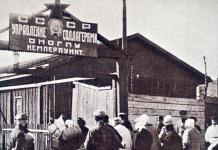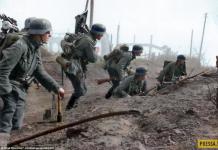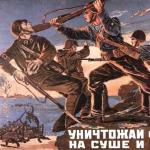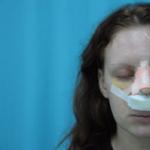| the day before yesterday, yesterday and tonight, I dug through dozens of reviews of this death on blogs. And probably only 5 percent understand that this was a total liar, who spent his entire life crap into people’s souls with his “art.” The overwhelming majority express all sorts of “bright sadness” and other “eternal memory” to the seasoned little man, the tough guy and the legendary man.
What are the reasons for such thoughtlessness of Russians (the bloggers here correctly reflect the general mood of the Russian population)? In ignorance (consciously, however, encouraged by the current authorities). Every day they should read texts like this post of the Other, and we would hear fewer regrets about such people (otherwise, soon another fighter on the ideological front will throw off his hooves, and sobs will shake the country again).
Power Solotetskaya
“The harsh climatic conditions, labor conditions and the fight against nature will be a good school for all sorts of vicious elements!” - the Bolsheviks who appeared on Solovki in 1920 decided. The monastery was renamed the Kremlin, White Lake into Red Lake, and a concentration camp for prisoners of war of the Civil War appeared on the territory of the monastery. In 1923, this camp grew into SLON - “Solovetsky Special Purpose Camps”. It is interesting that the first prisoners of SLON were activists of those political parties that helped the Bolsheviks seize power in the country.
The “special purpose” of the Solovetsky camps was that people were sent there not for crimes or misdemeanors, but those who posed a threat to the red regime by the very fact of their existence.
The new government destroyed active opponents immediately.
Those whose upbringing was not consistent with communist practice, who, due to their education, origin or professional knowledge, turned out to be “social aliens” were imprisoned in concentration camps. Most of these people ended up in Solovki not by court verdicts, but by decisions of various commissions, boards, and meetings.

On Solovki, a model of a state was created, divided along class lines, with its own capital, Kremlin, army, navy, court, prison and material base inherited from the monastery. They printed their own money, published their own newspapers and magazines. There was no Soviet power here, there was Solovetsky power here - the first local Council of Deputies appeared in Solovki only in 1944. ( It should apparently be added that Soviet power in the rest of the country was “Soviet” only in name. T.N. The “Soviets” were decorative bodies that obeyed the Communist Party (Bolsheviks) and its armed detachment of the Cheka in everything. That. on Solovki there was only formally no “Soviet” power, i.e. authorities of local councils. In fact, the true Soviet power was there, and in its most concentrated expression - approx. )

At first, work in the camp had only educational value. Former university teachers, doctors, scientists, and qualified specialists carried water from one ice hole to another in the winter, moved logs from place to place in the summer, or shouted greetings to their superiors and the Soviet government until they lost consciousness. This period of the formation of the camp system was distinguished by the mass death of prisoners due to backbreaking labor and abuse by guards. Following the prisoners, their guards were also destroyed - in different years, almost all the party leaders who created SLON and the security officers who managed the camp administration were shot.

The next stage in the development of the camp system in Solovki was the transfer of the camp to self-financing, to obtain maximum profit from the forced labor of prisoners, and the creation of more and more SLON branches on the mainland - from the Leningrad region to Murmansk and the Urals. Dispossessed peasants and workers began to be sent to Solovki. The total number of prisoners increased, the new camp law began to read “Bread according to production,” which immediately brought elderly and physically infirm prisoners to the brink of death. Those who fulfilled the norms were awarded with certificates and bonus pies.

Slogan on the wall of the Red Corner of the former punishment cell in the Savvatievo camp
The birthplace of the Gulag - Solovki - after the destruction of its own natural resources (ancient forests of the archipelago) pumped most of the prisoners for the construction of the White Sea-Baltic Canal. The isolation regime became increasingly stricter; from the mid-1930s, prisoners were transferred to prison conditions.
In the fall of 1937, an order came to Solovki from Moscow regarding the so-called. "norms" - a certain number of people who must be executed. The prison administration selected two thousand people who were shot. After this, SLON was withdrawn from the GULAG and turned from the camp into a model prison of the Main Directorate of State Security, which had five departments on different islands.

In 1939, the construction of a special Large Prison Building was completed. Colleagues of the “iron commissar” Nikolai Ivanovich Yezhov, who had already been executed in Moscow by that time, could well have been here, but the Solovetsky prison, on the orders of the new people’s commissar Beria, was suddenly urgently disbanded. The Second World War begins and the territory of the archipelago was required to organize a naval base for the Northern Fleet on it. The large prison building remained uninhabited. At the end of the autumn of 1939, the prisoners were transferred to other places in the Gulag.



In front of me lies a bibliographic rarity - the book by Yu. A. Brodsky "Solovki. Twenty Years of Special Purpose." For thirty-eight years, Yuri Arkadyevich has been collecting materials about SLON - eyewitness accounts, documents. His archive contains several thousand negatives of photographs that he took in places associated with the camp on Solovki. In 2002, with the assistance of the Soros Foundation and the Swedish Embassy in the Russian Federation, a book was published that Brodsky wrote based on the collected material. The 525 pages of the book contain unique material - written memories of former SLON prisoners, documentary evidence, photographs. The book's circulation is negligible, but there is hope that it will be published again.

During the trip to Solovki, we were lucky - Yuri Arkadyevich found the strength (he is sick now) to meet with our group of journalists and conduct a short excursion to Sekirnaya Mountain - perhaps the most tragic place in the history of the Solovetsky camp.
I recorded the story of a person who knows everything about Solovki on video and I want to show you a small fragment from this recording:
VIEW ALL

Sekirnaya Mountain, one of the highest places on Bolshoi Solovetsky Island, has always had a bad reputation. According to legend, in the 15th century. two angels flogged a woman with rods who could have been a temptation for the monks on the island. To commemorate this “miracle,” a chapel was erected there, and in the 19th century, a church, on the top of which a lighthouse was built, showing the way for ships approaching Solovki from the west. During the camp period, a punishment cell at camp No. 2 (Savvatievo), known for its particularly harsh regime, was located on Sekirnaya Gora. Sitting on wooden poles for days on end and systematic beatings were the lightest forms of punishment, as prison officer I. Kurilko said during interrogation. On the site in front of the church, executions of prisoners in the punishment cell were periodically carried out.
Engineer Emelyan Solovyov said that he once observed prisoners in the punishment cell at Sekirka who were being driven to work on filling up a cemetery for people with scurvy and typhus:
“We guessed that the penalty box was approaching from Sekirnaya Mountain by a loud command: “Get out of the way!”Of course, everyone jumped to the side, and we were led past by emaciated, completely bestial-like people, surrounded by a large convoy. Some were dressed, for lack of clothes, in sacks. I didn’t see any boots on either one.”
From the memoirs of Ivan Zaitsev, who was placed in a punishment cell on Sekirnaya Gora and survived after a month of staying there:
“We were forced to undress, leaving only a shirt and underpants on. Lagstarosta knocked on the front door with a bolt. An iron bolt creaked inside and the huge heavy door opened. We were pushed inside the so-called upper penalty cell. We stopped in stupor at the entrance, amazed at the sight before us To the right and left along the walls, the prisoners sat silently in two rows on bare wooden bunks. The first row, with their legs down, and the second row, with their legs tucked under them, all barefoot, half naked, with only rags on their bodies. some are already like skeletons. They looked in our direction with gloomy, tired eyes, which reflected deep sadness and sincere pity for us, newcomers. Everything that could remind us that we were in the temple was destroyed and roughly whitewashed. The side altars have been turned into punishment cells, where beatings and putting on straitjackets take place. Where there is a holy altar in the temple, there is now a huge bucket for “great” needs - a tub with a board placed on top for the feet. In the morning and evening - verification with the usual dog barking “Hello!” It happens that, for sluggish calculation, a Red Army boy forces you to repeat this greeting for half an hour or an hour. Food, and very meager food at that, is given once a day - at noon. And so not for a week or two, but for months, up to a year."

During his visit to Solovki in 1929, the great proletarian writer Maxim Gorky visited Sekirnaya Gora (pictured) along with his relatives and OGPU employees. Before his arrival, the perches were removed, tables were set up, and newspapers were distributed to the prisoners, with orders to pretend that they were reading them. Many of the penalty prisoners began to hold newspapers upside down. Gorky saw this, walked up to one of them and turned the newspaper correctly. After the visit, one of the OGPU authorities left a note in the control log of the detention center: “When visiting Sekirnaya, I found proper order.” Maxim Gorky added below: “I would say – excellent” and signed it.
From the memoirs of N. Zhilov:
“I cannot help but note the vile role played in the history of the death camps by Maxim Gorky, who visited Solovki in 1929. He looked around, saw an idyllic picture of the heavenly life of the prisoners and was moved, morally justifying the extermination of millions of people in the camps. Public opinion of the world was deceived by him in the most shameless way. Political prisoners remained outside the writer’s field. He was completely satisfied with the leaf gingerbread offered to him, Gorky turned out to be the most ordinary man in the street and did not become either Voltaire, or Zola, or Chekhov, or even Fyodor Petrovich Haaz.

For decades, traces of the camp on Solovki were destroyed by local state security workers. Now, the “new owners” on the island are doing this. More recently, a wooden barrack stood on this site, in which during the camp years women sentenced to death at Sekirka were kept. The inscriptions made by the unfortunates still remained on the walls of the barracks. A few days before our arrival, the monks of the monastery cut the barracks for firewood.

This is the same famous staircase of three hundred steps on Sekirka, along which penal prisoners were forced to carry water ten times a day - up and down.
Dmitry Likhachev (future academician), who served his time on Solovki as a VRIDL (temporarily acting as a horse), said that the guards of Sekirnaya Gora lowered prisoners down these stairs, tying them to a rope - a short log. “Below there was already a bloody corpse, which was difficult to recognize. There, under the mountain, they immediately buried it in a hole,” wrote D. Likhachev.

Under the mountain is the place that Yu. Brodsky told about. People who were shot near the church on Sekirka were buried here. There are pits where several dozen people lie. There are holes that were dug then for future use - they were dug in the summer for those who would be shot in the winter.

Above the front door of this house in the area of the botanical garden is a wooden sign, on which you can still see the remains of the inscription: COMMENDATTOR'S OFFICE.

Disabled camp trip to the island. Bolshaya Muksalma is another of the remaining camp sites on Solovki. Bolshaya Muksalma is located ten kilometers from the monastery on the road from peat mining. Camp staff said that in the winter of 1928, two thousand and forty prisoners died at Bolshaya Muksalma. In the fall, disabled people collected from throughout the First Department were sent here, who could not be used on Solovki also because they were poor, did not have support from the outside, and therefore could not give a bribe.

Bribes on Solovki were very developed. The future fate of the prisoner often depended on them. “Rich” prisoners could get a job for bribes in the Sixth Guard Company, where the majority were priests guarding warehouses, workshops and vegetable gardens. Those who were sent to Muksalma knew that their days were numbered and they would die in winter. The doomed were herded into two-story bunks, one hundred people per room of thirty to forty square meters. meters. Lenten soup at lunch was brought in large tubs and eaten from a common bowl. In the summer, disabled people worked picking berries, mushrooms and herbs, which were going to be exported abroad. In the fall, they drove to dig holes for their future graves, so as not to dig them in the winter, when the ground froze. The holes were dug large - 60-100 people each. From snow drifts, the pits were covered with boards and with the onset of autumn cold, the graves began to be filled first with those with diseased lungs, then the rest. By spring, only a few people remained in this barracks.

Comrade Commandant Kem. lane point.
I earnestly ask for your order to return to me the two knives that were taken from me: a table knife and a pocket knife. I have false teeth; Without a knife, I can’t not only bite off a piece of sugar, but even a crust of bread.I brought from the Internal Prison of the GPU, where I had permission from both the doctor and the warden, knives, which were allowed as the only exception in the entire prison, due to my old age and my lack of teeth. Without first cutting up the bread with a knife, which, given out two weeks in advance, becomes very stale, I am deprived of the opportunity to eat it, and bread is my main food.
I respectfully ask you to put yourself in my position and order the knives to be returned to me.
Prisoner in the 4th barracks Vladimir Krivosh (Nemanich)*
Commandant's resolution:
The established rules are mandatory for everyone and there can be no exceptions!
* Professor V. Krivosh (Nemanich) worked as a translator at the Commissariat of Foreign Affairs. Fluently spoke almost all languages of the world, including Chinese, Japanese, Turkish and all European languages. In 1923, he was sentenced to ten years under Article 66, like most foreigners, “for espionage for the benefit of the world bourgeoisie” and exiled to Solovki. Released in 1928

P.S. With this short story about Solovki, I convey greetings to the deputy from United Russia, former Deputy Prosecutor General of the Russian Federation Vladimir Kolesnikov and his colleagues who want to return the monument to Felix Dzerzhinsky to Lubyanka Square.
photos: © drugoi
archival photographs and texts of memories © Yu. Brodsky "Solovki. Twenty years of special purpose", RPE, 2002
Created in 1923, it served as a kind of prototype for the entire future system of Gulag camps. The Gulag was not only a place of imprisonment for convicts, but was also engaged in production and economic activities.
And it was in the Solovetsky camp that this system was first used. How it began, what kind of production activities were carried out on Solovki and how the life of the convicts was organized will be described in this material. Photo materials and a film about the Solovetsky Special Purpose Camp in 1928 are given.

In 1923, USLON accepted property from the Solovki state farm worth 946,000 rubles. On October 1, 1929, the cost of USLON's island enterprises was 4,860,000 rubles.
A leather factory was built. The leather factory gave the following products:23/24 .. by 42 thousand rubles. 27/28 .. 707,000 rub. 28/29 .. 1,180,000 rub.
Agricultural farms were organized: Solovetsky agricultural farms had very valuable breeds of Kholmogory cattle, moreover, Solovetsky acclimatized, although they were in a neglected state at the time of acceptance. This cattle was awarded at the All-Union Agricultural Exhibition. The management immediately made every effort to preserve it and further cultivate the breed. Milk yield was increased to 28.8 quintals on average for the year. Agricultural products increase from 44,000 rubles. in 1923/1924 up to 253,000 rubles. in 1928/29.
A very valuable nursery of fur-bearing animals was organized with a steadily growing quality and quantity of “pets”. The nursery's products should have amounted to up to 725,000 rubles. in year.
In 1924, the administration structure of the SLON Directorate was formed, where two parts were responsible for the development of the camp’s production activities. The production and technical part of USLON was in charge of enterprises, factories and workshops; technical, construction, repair and forestry developments; labor force and its appropriate use; organization of the manufacturing and mining industries. At the same time, the economic part of USLON was assigned responsibilities for the control of fishing and hunting; carrying out work in utility repair shops; procurement and supply of materials, raw materials and household equipment to all production and technical enterprises, factories and industries; for the sale of products produced by enterprises
By 1927, the Solovetsky camps were turning into an extensive economic system. The priorities of production activities are shifting in the city of Kem (Karelian Autonomous Soviet Socialist Republic). The importance of the Kem transfer and distribution point (Kemperpunkt, or KPP) increased: while remaining a department of USLON, it had a much larger volume of labor than Solovetsky Island
But not only production and economic activities were carried out in the camp, but also cultural and educational activities, and sports sections also functioned. All this was done by the KVCH (cultural and educational part)
weather station on Solovki
Solovetsky Orchestra at KHF
Solovki camp library. By the end of 1927 it consisted of more than 3,000 volumes.
Printing house

Solovetsky magazine

post card

Solovetsky camp theater


Volleyball team

Ski competitions

Football team

Hockey players

Prisoners' satisfaction


Camp medical unit.


Camp pharmacy.
Water transport Solovki.
Steamship "Gleb Bokiy"...
Workers' village.
The main directions of economic activity of the camp.
Logging.  Peat mining.
Peat mining.

Brick factory.
Pottery factory.
Mechanical plant.
Sawmill.
Fishing industry.
Leather and clothing industry.
Solovetsky agricultural farms are prototypes of the giant farms of KarLag and SazLag.

Solovetsky livestock farming.

Livestock products.
Solovetsky fur farm.
After the decision was made to build the White Sea-Baltic Canal, the transfer of prisoners there began. The number of prisoners on the islands of the archipelago began to rapidly decrease.
After this, the rapid decline of Solovki began. The first role was given to giant camps supporting large construction projects like DmitLag, BamLag, BelBaltLag or giant farms like KarLag. The camp was first transformed into a special-purpose prison, and in 1939 it was completely closed as unnecessary (the population of STON on March 1, 1939 was 1,688 people, in addition, another 1,722 people were kept in the “camp regime”). Its territory was transferred to SevMorFlot.
Solovetsky Monastery- Solovetsky Monastery. SOLOVETSKY MONASTERY (Preobrazhensky), male, on the Big Solovetsky Island in the White Sea, founded in the 30s. 15th century Played a significant role in the economic development of Pomerania. In the 60s and 70s. 17th century one of the centers of schism. From 16... Illustrated Encyclopedic Dictionary
Male, on Solovetsky Island. in Beloye metro. Founded in the 30s. 15th century Played a significant role in the economic development of Pomerania. In the 60s and 70s. 17th century one of the centers of schism. At 16.00 20th centuries place of reference. After the October Revolution it was abolished. In 1923 39... ... Big Encyclopedic Dictionary
SOLOVETSKY MONASTERY, male, on Solovetsky Lake in the White Sea. Founded in the 30s. 15th century Large religious and cultural center; played a significant role in the economic development of Pomerania. In the 60s and 70s. 17th century one of the centers of schism. In the 16th beginning... ...Russian history
Monastery Solovetsky Monastery ... Wikipedia
Male, on Solovetsky Island in the White Sea. Founded in the 30s. XV century Large religious and cultural center. Played a significant role in the economic development of Pomerania. In the 60s and 70s. XVII century one of the centers of schism. In the 16th and early 20th centuries. place… … encyclopedic Dictionary
Monument Solovetsky Stone ... Wikipedia
Rural-type settlement Solovetsky Country RussiaRussia ... Wikipedia
Solovetsky: Populated areas Solovetsky village in the Arkhangelsk region on Solovetsky Island, the administrative center of the Solovetskoye municipality; Solovetsky village, Oryol district, Oryol region; Other... ... Wikipedia
Solovetsky Monastery- (Spaso Preobrazhensky Solovetsky Stavropegic Monastery) The Solovetsky archipelago consists of six large ones (Big Solovetsky Island, Anzer Island, Bolshaya and Malaya Muksalma Islands, Bolshoy and Maly Zayatsky Islands) and several... ... Orthodoxy. Dictionary-reference book
Vishera pulp and paper mill today Vishera forced labor camp, Vishera ITL, Vishlag, Visherlag forced labor camp, organized in 1928-1929. on the basis of the Vishera branch of the Solovetsky ITL OGPU... ... Wikipedia
ELEPHANT and people. 70 years ago, the Solovetsky Special Purpose Camp (SLON), the first concentration camp in the world, was closed.
Author - Yuri Brodsky, researcher of the history of Solovki.
The selection of books about history in the shop of the Solovetsky Monastery speaks for itself - pilgrims and tourists are offered books praising Stalin. At the same time, about a million people left their lives or part of their lives on the islands and their branches.
The transfer of all prisoners, the movement of prison personnel and the removal of material assets will be completed on December 15, 1939 - read the order of People's Commissar Lavrentiy Beria “ON THE CLOSING OF THE PRISON ON SOLOVKA ISLAND.” The prisoners were quickly evacuated to polar camps created at the suggestion of G. Ordzhonikidze for the development of the Norilsk copper-nickel deposit.
In late autumn, the prisoners, isolated even from each other on an island in the White Sea, were all simultaneously kicked out of their cells. The prisoners were awaited by a “dry bath,” that is, a strip search, and a general formation. Pale faces, identical dark blue jackets and pants with yellow stripes and yellow cuffs. The destinies are also similar. Mainly the intelligentsia. Doctors of the highest qualification; internationalists who fought against fascism in Spain; engineers who completed internships abroad; economists, former front-line officers, future academic microbiologist.
Very reminiscent of the sign on the gates of Auschwitz: “Work sets you free” (Arbeit macht frei).
With the increase in the number of political prisons in the USSR, the Bolshevik government had an idea to create a large Special Purpose Camp not near densely populated areas, but in an inaccessible distance from the entire country. In the 1920s a system of scattered throughout the state and placed in the close service of socialist construction Gulag Few people have planned it yet. The communists then found it useful to concentrate the most “dangerous” opponents of their regime in one place, isolated almost to the point of complete inaccessibility, from which it would not be easy to escape. The Solovetsky Islands were chosen as this place.
Solovetsky Monastery. Photo from 1915
The assertion that the prison on Solovki was a torture facility back in tsarist times is an invention of communist hacks. But in general, before the revolution, there was a prison here - for a few few prisoners, who over the course of three or four centuries can be counted almost on one hand (the famous figure of the Time of Troubles Avraamy Palitsyn, who died here, the last Zaporozhye Koshevoy Kalnishevsky, Pushkin’s uncle P. Hannibal, who was imprisoned for sympathy for the Decembrists). During the years of Nikonian reforms, the island monastery became famous for the eight-year (1668-1676) Solovetsky uprising for the old faith.
In the first time after the revolution of 1917, the Solovetsky Monastery was declared a state farm. The monks “were ordered to pray less and work more for the benefit of the workers and peasants” (the herring they caught in the White Sea went to the Kremlin table). But the abundance of valuables concentrated in the monastery confused some of the visiting leaders and commissars. And then, in some contradiction with the criminal code, but in true accordance with the general spirit of expropriation of “unearned property,” the monastery was set on fire (May 25, 1923). At the same time, all the accounting books burned, and it was impossible to determine how much and what exactly was missing. The Bolsheviks accused the “black monastic pack” of forgery. It was decided to throw it onto the mainland, and to concentrate the Northern Special Purpose Camp on the Solovetsky Islands. Only the monastery team of fishermen, livestock specialists and sauerkraut specialists remained here.
In June 1923 security officers came to Solovki to create “an exemplary strict camp, the pride of the Workers’ and Peasants’ Republic.” Northern Special Purpose Camps were actually founded already in 1921 - in Pertominsk, Kholmogory and near Arkhangelsk itself. But these places were apparently considered difficult to guard and unpromising for condensing large masses of prisoners. And the eyes of the authorities, naturally, were transferred next door to the Solovetsky Islands - with an already established economy, with stone buildings, 20-40 kilometers from the mainland, close enough for jailers, remote enough for fugitives and six months without communication with the mainland - a tougher nut to crack, than the former royal convict Sakhalin. The first head of the Solovetsky camp was the famous security officer Eichmans.
The rules established in the Solovetsky camp were very cruel. They didn’t give me any clothes: they caught me in a summer dress and so go through the polar winter. People carried carts and sleighs instead of horses. As in the Gulag later, in the mornings the company officers kicked their workers out to work. In the Sekirke punishment cell, guilty Solovetsky prisoners were forced to sit all day on arm-thick poles, reinforced so that their feet did not reach the ground (the guards beat those who fell down). Those especially guilty were pushed tied to a log down 365 steep steps, and in the summer they were placed naked under clouds of northern mosquitoes. Public executions were also practiced in the Solovetsky camp for minor violations of the regime (for example, for visiting a church, reserved for the remaining monastic artels, without permission from the authorities). And yet the “Solovetsky” era of camp life was very different from the subsequent, Stalinist one. The Solovki were not hidden from the country, they were even openly proud of them, everyone’s ears were buzzing about them, and they were constantly mentioned in pop couplets. The magazine “SLON” (Solovetsky Special Purpose Camp) published here was distributed in large quantities throughout the country.
Solovetsky Power - Evidence and documents
The camp grew quickly. Already in the first six months, more than 2,000 prisoners were sent here, and by 1928 there were already about sixty thousand (since 1926, in addition to political prisoners, seasoned criminals began to be sent to Solovki). In addition to the main prison – the local Kremlin – “business trips” also appeared on other islands of the Solovetsky archipelago. The terms have so far been short - rarely 10 or 5 years, mostly 3 years. There were many old intelligentsia in the camp; philosophers, historians, literary scholars, financiers, lawyers; Refined intellectual treatment of each other was common among them. Despite the shortness of their sentences, few were released: when the sentences ended, Stalin’s Gulag camps had already begun to open - and the Solovetsky prisoners were re-convicted.
The internal management of the Solovetsky camp was characterized by a struggle between the KGB “information and investigative unit” (ISCh, seksot) and the “administrative unit”, which was in charge of current security and was recruited mainly from former White Guards. The White Guards caught the informers, sent them to the usual stages, in 1927 they broke into the ISCH, broke into the fireproof cabinet, removed them from there and announced the full lists of informers. But over the years, there were fewer and fewer former white officers in the Administrative Unit of the Solovetsky camp. The number of criminals among its personnel grew, and clashes within the prison administration ceased.
In the first year or two of the camp's existence, the security officers completely destroyed the once flourishing monastic economy (the monks grew high-quality vegetables here - even melons, caught the best fish - and bred it, kept greenhouses, had their own mills, sawmills, foundry, forge, bookbinding and pottery workshops, even their own power plant, they themselves made complex shaped bricks and sea boats). There was nothing to feed the prisoners of the Solovetsky camp: the dead were hidden under bunks in order to get extra rations for them. Epidemics of typhus and smallpox broke out (60% of prisoners died from typhus in the neighboring mainland Kem), and scurvy became widespread.
The system of labor - the main task of the subsequent Stalinist Gulag - in the Solovetsky special purpose camp was still poorly developed. The prisoners here mainly carried out tasks according to their own contents and (as punishment) various meaningless orders, such as pouring water from an ice hole to an ice hole or dragging logs from one place to another and back. According to state statistics, until 1929 in the RSFSR, only 35-40% of prisoners were subject to forced labor - without camp maintenance - and it could not have been otherwise given the unemployment in the country.
But since the first five-year plan the situation has changed dramatically. The camps began to be put into service industrialization. If in 1926 SLON harvested forests - not for itself, but for “external” orders - for 63 thousand rubles, then in 1929 - for 2355 thousand rubles, and in 1930 - three times more. In 1926, road construction was completed in the Karelo-Murmansk Territory for 105 thousand rubles, in 1930 - for 6000 thousand rubles. The mainland city of Kem previously served as a transit point for the Solovetsky camp, through which prisoners entered the archipelago. But now, through him, the SLON camp began to spread to the mainland. To the west of Kem, through the swamps, prisoners taken from Solovki began to lay the unpaved Kem-Ukhtinsky tract, which was once considered almost impossible. Then they led the Parandovsky tract from Medvezhyegorsk. With great difficulty, they built a 27 km dirt road on the Kola Peninsula. to Apatity, covering the swamps with logs and sand embankments, leveling the capricious reliefs of the crumbling slopes of rocky mountains. Then SLON built a railway there - 11 kilometers in one winter month. (The task seemed impossible - 300 thousand cubic meters of excavation! in winter! beyond the Arctic Circle, when the earth is worse than any granite!).

To the Solovetsky camp from the Kemsky transit point
Thus, the previous plan of a Special Purpose camp closed on the islands fell apart. It became a thing of the past due to the “interests of communist construction.” The camps began to spread throughout the country - and in accordance with the new conditions, the task was set to “wage a fight against free men hobnobbing with prisoners, hiding fugitives, buying stolen and government-owned items from prisoners, all sorts of malicious rumors spread about SLON by class enemies.” It was necessary to isolate the prisoners from the civilian population. After several successful sea escapes from the Solovetsky camp in Europe, true news about the order in the Soviet camps began to spread among those who had escaped. The All-Russian Central Executive Committee sent a verification commission to the north of “the conscience of the party - Aron Solts”, which traveled along the Murmansk railway without ruling anything special. Then the great proletarian writer Maxim Gorky was sent to Solovki” (June 1929), who behaved unusually vilely in the camp (for details, see A.I. Solzhenitsyn’s book “The Gulag Archipelago”). After his visit, the Solovetsky prisoners were subjected to extreme terror. One failed escape was inflated into a huge White Guard conspiracy - the Whites were supposedly going to seize the ship and sail away - and 300 people were shot on the night of October 15, 1929 (then additional parties brought from the mainland).

Gorky on Solovki surrounded by security officers (to the left of Gorky is the famous Gleb Bokiy). 1929
Since the late 1920s, prostitutes, household workers, and punks have poured into Solovki in a wide stream. The social composition of the camp prisoners was changing rapidly. With the expansion of the scale of forced labor, the authorities, as elsewhere in these years, began to encourage “socialist competition among prisoners.” In the fall of 1930, the Solovetsky headquarters for competition and shock work was created. The role of shock workers was mainly played by thieves, who took away work from other camp inmates and claimed that they had fulfilled several standards. In official Soviet literature, without the slightest irony, it was narrated how notorious repeat offenders, murderers and raiders suddenly “acted in the role of thrifty business executives, skilled technologists, capable cultural workers.” Thieves and bandits created a “commune” in the Solovetsky camp, proclaimed their reforging and re-education, and the authorities moved the “communards” to separate dormitories, began to feed and clothe them better than other prisoners. The percentage of compliance with the norms among the members of the “commune” inexplicably doubled. The conference of the “Solovetsky shock brigades” decided to “respond with a broad wave of socialist competition to the new slander of the capitalists about forced labor in the USSR. However, already in the spring of 1931, a general purge of the so-advertised “successful brigades” and “communes” was suddenly required - all their “labor achievements” turned out to be fake.
From Solovki, the system of camps was transferred to the Novaya Zemlya islands. There were, most likely, the most terrible special purpose camps - not a single prisoner returned from here, there is no information about their history.
Based on materials from the book by A. I. Solzhenitsyn “The Gulag Archipelago”


















